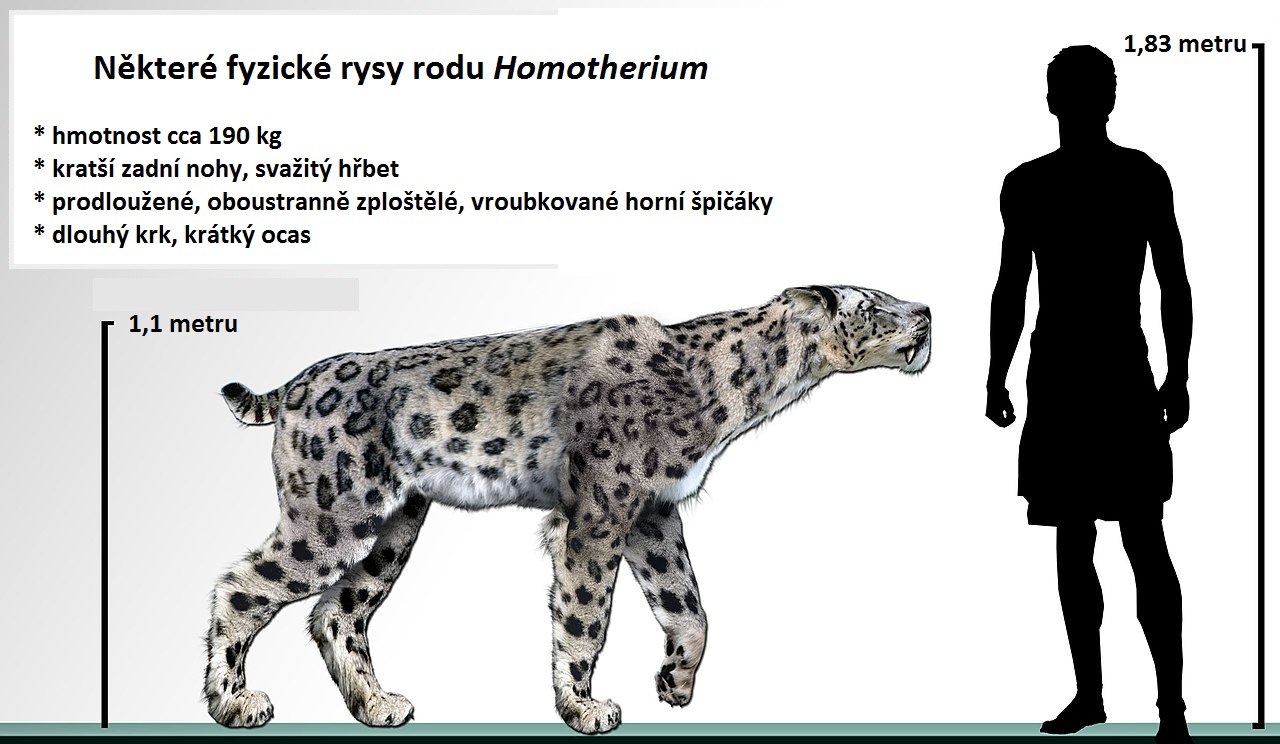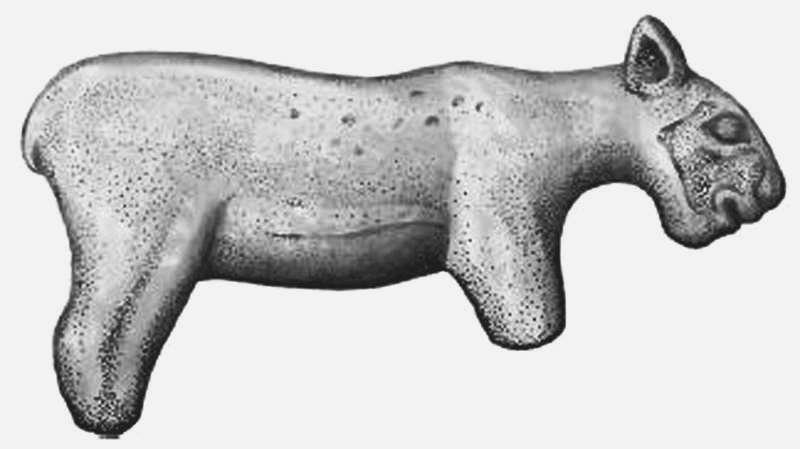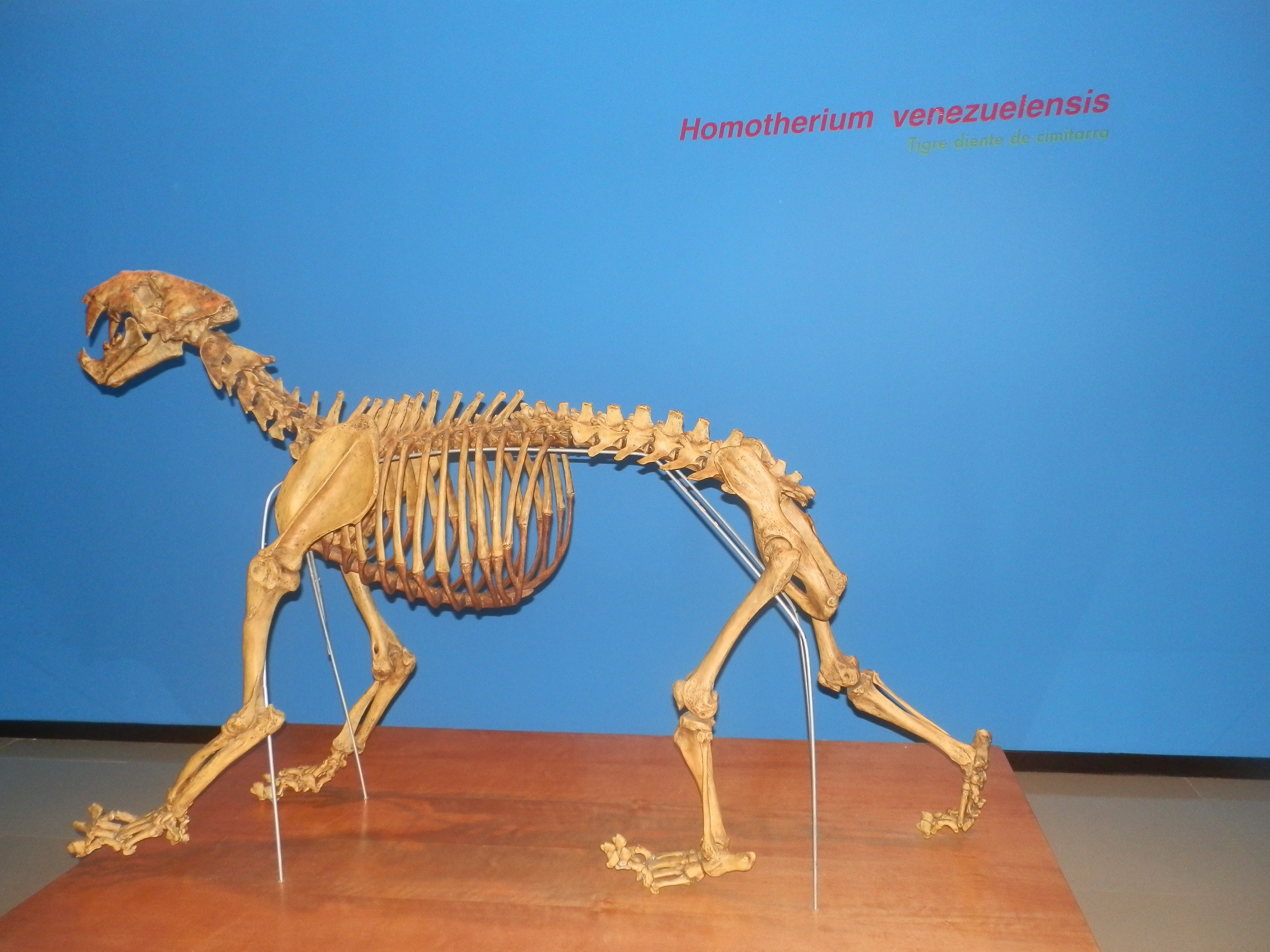시미타고양이
"오늘의AI위키"의 AI를 통해 더욱 풍부하고 폭넓은 지식 경험을 누리세요.
1. 개요
시미타고양이(Homotherium)는 멸종된 검치호랑이의 한 속으로, 플라이오세 초기부터 플라이스토세 후기까지 유라시아, 아프리카, 북아메리카, 남아메리카 등지에 서식했다. 1846년 처음 기술되었으며, 다양한 종이 존재했으나, 2014년 연구에서는 유라시아에서 H. latidens 단일 종만 인정했다. 시미타고양이는 사자와 비슷한 크기로, 긴 다리와 짧은 꼬리, 톱니 모양의 송곳니, 하이에나와 유사한 앞니 배열을 특징으로 한다. 큰 먹이를 사냥하는 데 적응했으며, 집단 사냥을 했을 것으로 추정된다. 고대 인류와 공존했으며, 멸종에는 기후 변화, 경쟁, 인간의 사냥 등이 영향을 미쳤을 수 있다.
더 읽어볼만한 페이지
- 마카이로두스아과 - 제노스밀루스
제노스밀루스는 초기 플라이스토세 시대 북미에 살았던 멸종된 고양이과 동물로, 튼튼한 체격과 독특한 송곳니 형태를 지니며 사회적 동물이었을 가능성이 제기된다. - 신생대 유럽의 포유류 - 매머드
매머드는 약 550만 년 전 아프리카에서 출현하여 유라시아와 북아메리카로 퍼져나간 코끼리과의 멸종된 포유류 속으로, 털매머드와 같이 빙하기에 적응한 종은 인류와 공존하며 멸종되었으나, 영구 동토층에서 발견되어 고생물학 연구의 대상이 되고 있다. - 신생대 유럽의 포유류 - 히파리온
히파리온은 마이오세 시대에 번성했던 세 개의 발가락을 가진 중간 크기의 멸종된 말의 한 종류로, 숲과 초원으로 이루어진 사바나 생물 군계에 서식하며 풀을 주식으로 섭취했고, 약 1100만 년 전 코르모히파리온에서 진화하여 구세계에서 기후 변화로 인해 멸종되었다. - 신생대 아시아의 포유류 - 매머드
매머드는 약 550만 년 전 아프리카에서 출현하여 유라시아와 북아메리카로 퍼져나간 코끼리과의 멸종된 포유류 속으로, 털매머드와 같이 빙하기에 적응한 종은 인류와 공존하며 멸종되었으나, 영구 동토층에서 발견되어 고생물학 연구의 대상이 되고 있다. - 신생대 아시아의 포유류 - 히파리온
히파리온은 마이오세 시대에 번성했던 세 개의 발가락을 가진 중간 크기의 멸종된 말의 한 종류로, 숲과 초원으로 이루어진 사바나 생물 군계에 서식하며 풀을 주식으로 섭취했고, 약 1100만 년 전 코르모히파리온에서 진화하여 구세계에서 기후 변화로 인해 멸종되었다.
| 시미타고양이 - [생물]에 관한 문서 | |
|---|---|
| 기본 정보 | |
 | |
| 학명 | Homotherium |
| 명명자 | Fabrini, 1890 |
| 속 | 호모테리움속 |
| 아과 | 마카이로두스아과 |
| 족 | 호모테리움족 |
| 시대 | 신제3기플리오세 초기 ~ 제4기플라이스토세 말기 |
| 영문명 | Scimitar cat (시미터 고양이) |
| 종 | |
| 기타 종 | Homotherium ischyrus (Merriam, 1905) Homotherium serum (Cope, 1893) Homotherium venezuelensis? (Rincón et al., 2011) |
| 과거 학명 | |
| 과거 학명 | Dinobastis Cope, 1893 |
2. 역사, 분류 및 진화
리처드 오웬은 1846년 영국 데번 주 켄트 동굴에서 1826년에 존 맥에너리 목사가 발견한 플라이스토세 시대의 송곳니를 바탕으로 ''Machairodus latidens'' 종을 처음 기술했다.[3] 1890년 에밀리오 파브리니는 아래 앞어금니 사이에 큰 이개(diastema)가 있는 것이 주요 특징인 ''Machairodus''의 새로운 아속으로 ''Homotherium'' (고대 그리스어: ὁμός|homos|같음grc와 θηρίον|therion|짐승grc)을 제안했다.[5]
''호모테리움''은 큰 먹이를 사냥하는 데 적응했을 것으로 추정된다.[45] 감소된 발톱, 비교적 가늘고 긴 다리, 경사진 등은 모두 개방된 서식지에서 적당한 속도로 지구력을 발휘하는 데 적응한 것으로 보인다.[47][45] 앞다리의 달리기 적응 형태는 이들이 먹이를 잡고 제압하는 데 있어 ''스밀로돈'' 또는 현존하는 많은 고양이과 동물보다 덜 유용했음을 시사하며, 대신 턱 앞쪽의 확대된 앞니가 하이에나와 개과 동물처럼 이 기능을 수행했다.[45] ''호모테리움''이 송곳니로 목을 베어 먹이를 죽였을 가능성이 제기되었지만, 먹이를 제압하는 방식은 ''스밀로돈''과는 달랐을 것이며, 사자와 같은 현존하는 고양이과 동물이 사용하는 물어잡기 방식과 유사한 살해 기술을 사용했을 것이다.[48] 개방된 서식지에 적응하고 다른 육식 동물과의 경쟁이 치열했던 점을 고려할 때, ''호모테리움''은 아마도 집단 사냥에 의존했을 것으로 추측된다.[45]
''호모테리움''은 아프로-유라시아 전역에서 고대 인류와 오랫동안 공존해 왔으며, 그 시기는 아프리카의 플라이오세 시대 ''오스트랄로피테쿠스''부터 중국 저우커우디엔 동굴의 전기-중기 홍적세 시대 ''호모 에렉투스'', 유럽의 중기 홍적세 시대 ''호모 하이델베르겐시스''까지 다양하다. 중기 홍적세 시대에 유럽에서 ''호모테리움 라티덴스''가 멸종한 것은 ''호모 하이델베르겐시스''(사자 ''판테라 포실리스'')와의 경쟁 결과일 수 있다.[47]
[1]
서적
Sabertooth
https://archive.org/[...]
Indiana University Press
2013
이후 유라시아, 아프리카, 아메리카 대륙에서 다양한 종들이 기술되었으나, 2014년 연구에서는 후기 플라이오세-플라이스토세 동안 유라시아에서 단 하나의 ''Homotherium'' 종, 즉 ''Homotherium latidens''만 인정했다.[36] 다른 연구에서는 ''Homotherium crenatidens''를 ''H. latidens''보다 연대기적으로 더 이른 유효한 범유라시아 종으로 인정하기도 한다.[13]
아프리카에서는 여러 종이 명명되었으나, 단편적인 화석 자료로 인해 특정 종으로 귀속시키는 것에 어려움이 있었다.[36] 1972년 남아프리카 마카판스갓 지역에서 발견된 화석을 바탕으로 ''Homotherium problematicum'' 종이 명명되었고,[14][15] 1988년에는 에티오피아 하다르 층에서 ''Homotherium hadarensis'' 종이 기술되었다.[16] 2015년에는 하다르 층에서 추가 화석이 발견되어 ''H. hadarensis''에 속하는 것으로 추정되었다.[17] 튀니지 아인 브림바에서 발견된 유해를 바탕으로 ''Homotherium africanum'' 종도 포함되었으나,[18][19][20] 초기-중기 플라이오세 시대로 추정된다.[21]
아메리카 대륙에서는 ''Ischyrosmilus'', ''Dinobastis'' 등의 속이 ''Homotherium''과 동의어로 간주되면서 여러 종이 ''Homotherium'' 속으로 재분류되었다. 1905년 메리엄은 ''Machaerodus ischyrus'' 종을 기술했고,[22] 1918년에는 이 종을 ''Ischyrosmilus'' 속으로 재분류하며 ''Ischyrosmilus idahoensis'' 종을 추가했다.[23] ''Dinobastis'' 속은 1893년 에드워드 드링커 코프에 의해 처음 명명되었으며, 기준종은 ''Dinobastis serus''였다.[24] 1966년 처처는 ''Dinobastis''를 ''Homotherium''의 후배 동의어로 명명하고, ''D. serus''를 ''Homotherium serum''으로 재조합했다.[26] 이후 여러 논쟁 끝에 ''Ischyrosmilus'' 속은 ''Homotherium''의 후배 동의어로 선언되었고, 네 종 모두 ''Homotherium'' 속으로 재분류되었다.[28]
최근 연구에서는 남아메리카의 ''Homotherium venezuelensis''를 ''Xenosmilus'' 속으로 재분류할 것을 제안하기도 한다.[33] 2005년 베네수엘라 화석을 기반으로 ''Homotherium venezuelensis'' 종이 기술되었으나,[31] 2022년 ''Xenosmilus'' 속으로 재분류할 것이 제안되었고,[33] 2024년 다른 연구 그룹이 이를 지지했다.[33]
미토콘드리아 DNA 염기 서열을 기반으로 호모테리움의 계통은 약 1,800만 년 전에 스밀로돈과 분기된 것으로 추정된다.[34] 호모테리움은 약 400만 년 전 초기 플라이오세에 처음 등장했으며, 아프리카의 ''암피마카이로두스'' 속에서 유래했을 가능성이 제기된다.[35]
호모테리움은 후기 플라이오세에 북아메리카에 도달했으며,[36] 아프리카에서는 초기 플라이스토세 동안 약 150만 년 전에 사라졌다.[38] 유럽에서 발견된 가장 최근의 호모테리움 유해는 약 30만~20만 년 전이며,[40] 북해에서 발견된 하악골은 약 2만 8천~3만 년 전으로 거슬러 올라간다.[40] 2024년에는 시베리아 북동부에서 상부 플라이스토세에 속하는 ''호모테리움 라티덴스'' 새끼의 미라가 보고되어, 아시아 상부 플라이스토세에서 이 종의 존재를 확인시켜 주었다.[41] ''호모테리움 세룸''은 약 12,000년 전에 북아메리카에서 멸종되었다.[42]
3. 특징

시미터 고양이(''Homotherium'')는 어깨 높이가 1.1m에 달했고, 몸무게는 약 190kg으로 추정되어 수컷 사자와 비슷한 크기였다.[43][44] 스밀로돈에 비해 다리가 상대적으로 길었고 앞다리는 덜 발달하여 치타와 사자의 중간 형태를 보였다. 목은 상대적으로 길고 두꺼우며 유연성이 높았고, 등은 비교적 짧았다. 꼬리는 매우 짧았다. 발톱은 작고 반쯤 숨길 수 있었으며 족근골은 컸고 두 번째 발가락 뼈는 사자의 발가락 뼈보다 비대칭성이 적어 개의 발과 같은 자세를 보였다. 발에 가장 가까운 위팔뼈 부분은 좁았고 주두 오목은 강하게 수직이었다. 뒷발은 들어올려진 지행성 자세를 유지했다. 시미터 고양이는 살아있는 대형 고양이와 하이에나의 중간 자세, 즉 개과 동물과 비슷한 자세로 걸었을 가능성이 높다.[45]
조상으로 보이는 ''Amphimachairodus''와 비교했을 때, 위쪽 앞니는 더 강한 톱니 모양을 보이며, 크고 더 아치형이며, 위쪽 두 번째 어금니(P2)는 항상 없고, 위쪽과 아래쪽 세 번째 어금니(P3 및 p3)는 더 작으며, 위쪽 네 번째 어금니(P4)의 형태는 차이를 보인다.[32] 표범아과에 속하는 호랑이나 사자와 같은 현존하는 대형 고양이와 비교했을 때, 시미터 고양이는 코 부위가 더 높고, 두개골 윗부분(등쪽 부위)의 윤곽선이 더 직선적이고 시상 능선이 높은, 더 길고 좁은 두개골을 가지고 있다.[57] 시미터 고양이는 Smilodontini 부족의 구성원인 스밀로돈이나 ''Megantereon''보다 짧은 위쪽 송곳니를 가지고 있었지만, 이것은 현존하는 고양이의 송곳니보다 여전히 길었다.[45] 그것의 큰 위쪽 송곳니는 넓고, 뚜렷하게 납작하며 거칠게 톱니 모양을 하고 있다.[54] 시미터 고양이의 큰 위쪽 송곳니는 스밀로돈의 큰 위쪽 송곳니와 달리 현존하는 고양이와 유사하게 위 입술과 아래 턱의 잇몸 조직에 의해 가려졌을 가능성이 높다. 이러한 가설은 턱을 완전히 닫았을 때 송곳니와 아래턱 사이의 비교 가능한 공간으로 더욱 뒷받침된다; 반면에 스밀로돈은 이러한 점에서 훨씬 더 많은 공간을 가지고 있어, 송곳니와 아래턱 사이에 부드러운 조직이 들어갈 수 있도록 했을 것이다.[46] 앞니는 현존하는 대형 고양이에 비해 확대되었으며,[57] 턱 앞쪽에 아치형으로 배열되어 하이에나와 개과 동물과 유사하다.[45] 아래턱의 두 반쪽을 연결하는 부분(하악 결합)은 각지고 높으며, 하악골의 근돌기는 비교적 짧다.[57]
몸길이는 1.2m[61], 어깨 높이는 1.1m, 몸무게는 190kg으로 추정된다.[79][80] 시미터 고양이의 위턱 송곳니는 스밀로돈이나 메간테레온과 같은 근연 마카이로두스아과 속과 비교하면 짧았지만, 현생 대형 고양이과 동물과 비교하면 길었다. 시미터 고양이의 앞니와 아래턱 송곳니는 먹이를 강하게 찔러 확보하는 기능이 있었다. 다만 어금니는 약해서 뼈의 파쇄에는 적합하지 않았다. 두개골은 스밀로돈보다 길었고, 아래턱을 움직이는 근육이 부착되는 Sagittal crest|시상 능선영어이 발달했다. 아래턱에는 위턱의 송곳니를 보호하는 아래로 발달한 돌기가 존재했다. 긴 송곳니는 순수하게 먹이를 찌르기보다는 찢는 데 적합하다는 견해도 있는 한편, 2018년 Figueirido 등의 연구에 따르면 시미터 고양이는 현생 사자처럼 송곳니로 데미지를 주면서 먹이를 잡는 물기를 했다고 발표되었다. 이는 시미터 고양이 속의 두개골에 해면골이 많이 포함되어 있기 때문이다. 이러한 물기는 지금까지 비교되어 온 스밀로돈의 송곳니의 전단 교합과는 달리, 다른 생태적 적응의 증거가 된다.[81]
2020년 시베리아에서 발견되어 2024년에 기술된 생후 3주 된 'H. latidens' 새끼의 연조직은 이 종의 어린 개체의 털 색깔이 검정색 또는 짙은 갈색이고 발과 턱이 옅다는 것을 나타낸다. 입가 부위와 목 뒤쪽의 털은 미라의 앞다리보다 길었다. 또한, 새끼는 넓고 둥근 발을 가지고 있었고 발목 패드가 없었으며, 털이 조밀하여 눈이 많이 내리는 지형을 효과적으로 가로지르기 위한 적응력을 보여주었으며, 이러한 특징은 어린 나이에 발달했다는 것을 보여준다.[41] 호모테리움의 화석이 평원과 같은 열린 환경에서 얻어지고, 현생 고양이과 동물과의 비교를 통해 동물행동학자 윌리엄 알렌은 호모테리움이 사자처럼 수수한 색을 띠었을 것으로 추측했다.[82]
4. 고생태
유콘의 영구 동토층에서 발견된 ''호모테리움'' 표본의 게놈 분석 결과, ''호모테리움''은 호흡 및 순환계와 관련된 유전자에 대한 양성 선택을 경험했으며, 이는 지구력 달리기에 대한 적응일 수 있다. 시력과 관련된 유전자에 대한 양성 선택은 사냥에 시력이 중요한 역할을 했음을 나타내며, 이는 ''호모테리움''이 주행성 (낮에 활동하는) 사냥꾼이었음을 시사한다.[49]
스페인 벤타 미세나 지역에서 발견된 ''H. latidens''의 동위 원소 분석 결과, 이 지역에서 ''H. latidens''는 최상위 포식자였으며, 개방된 서식지에서 큰 먹이(말, 들소, 어린 맘모스 포함)를 사냥했다.[50] 텍사스주 프라이젠한 동굴 유적지에서는 수많은 ''호모테리움 세룸''의 뼈와 함께 거의 400마리의 어린 콜럼비아 맘모스의 유해가 발견되었는데, 이는 ''호모테리움''이 어린 맘모스를 전문적으로 사냥했음을 시사한다.[52] 동부 베링기아(현재 알래스카와 유콘)에서 발견된 ''H. serum'' 표본의 동위 원소 분석 결과, 이 지역에서 이 종은 맘모스 전문 포식자가 아니었으며, 들소, 사향소, 말, 순록뿐만 아니라 털매머드를 포함한 다양한 큰 먹이를 소비했다.[55]
5. 인간과의 관계

켄트 동굴에서 발견된 ''H. 라티덴스''의 송곳니에 대한 동위원소 분석 결과는, 동굴에서 발견된 다른 동물 유해와 동위원소적으로 뚜렷한 차이를 보였다. 이는 동굴에서 다른 ''호모테리움''의 유해가 전혀 발견되지 않은 것과 함께, 이빨이 구석기 시대에 인간에 의해 멀리 떨어진 곳(아마도 유럽 본토)에서 의도적으로 동굴로 옮겨졌을 수 있다는 주장의 근거가 되었다. 어쩌면 일종의 거래 상품으로 사용되었을 수도 있다. 이빨은 켄트 동굴로 옮겨지기 전에 상당한 풍화 작용을 겪었던 것으로 보이며,[56] 이러한 이빨이 비교적 최근에 죽은 ''호모테리움''의 유해에서 가져온 것인지, 아니면 오래전에 죽은 ''호모테리움'' 개체의 화석 유해에서 가져온 것인지는 불분명하다.[4] 프랑스 남서부 이스트리츠 동굴에서 발견된, 현재는 사라진 구석기 시대 조각상은 일부에서 ''호모테리움''을 나타내는 것으로 주장하기도 하지만, 다른 학자들은 해부학적 비율과 후기 홍적세 유럽에서 ''호모테리움''의 유해에 비해 동굴 사자의 유해가 훨씬 더 많이 발견된 점을 들어 동굴 사자를 나타낼 가능성이 더 높다고 주장한다.[57]
북아메리카의 후기 홍적세 말기에 ''호모테리움 세룸''은 아메리카 대륙에 처음으로 거주한 인간인 고대 인디언과 공존했다. ''H. 세룸''이 의존했던 대형 초식 동물을 인간이 사냥한 것이 북아메리카의 다른 대형 육식 동물과 함께 멸종에 기여한 요인일 수 있다.[58]
참조
[2]
서적
'The big cats and their fossil relatives
Columbia University Press
[3]
서적
A History of British Mammals and Birds
1846
[4]
논문
An inventory of British remains of ''Homotherium'' (''Mammalia'', ''Carnivora'', ''Felidae''), with special reference to the material from ''Kent's Cavern''
2014-01
[5]
논문
I Machairodus (Meganthereon) del Val d'Arno superiore
https://www.biodiver[...]
[6]
논문
První nálezy Machaerodů v jeskynním diluviu moravském a dolnorakouském
1916
[7]
논문
Fossil mammals from Locality 9 of Choukoutien
1936
[8]
논문
Kvabebskaya Fauna Akchagyl'skikh pozvonochnykh
1972
[9]
논문
New data on the Pliocene carnivore fauna of Odessa Catacombs
2004
[10]
논문
Kuruksajskij kompleks pozdnepliocenovych mlekopitajushchikh Afgano-Tadshikskoj depressii
1986
[11]
논문
On a new species of the saber-toothed cat from the Late Eopleistocene of the Afgano-Tadjik depression and the evolution of the genus Homotherium Fabrini, 1890
1989
[12]
서적
Cenozoic mammals and environment of Hengduan Mountains Region
China Ocean Press
1996
[13]
논문
The first complete cranium of Homotherium (Machairodontinae, Felidae) from the Nihewan Basin (northern China)
https://anatomypubs.[...]
2022-07-12
[14]
논문
A new species of machairodont from Makapansgat
1972
[15]
논문
Geology, Fauna, and Paleoenvironmental Reconstructions of the Makapansgat Limeworks Australopithecus africanus -Bearing Paleo-Cave
https://www.cambridg[...]
Cambridge University Press
2024-11-15
[16]
논문
Nouveau felidé machairodonte (Mammalia, Carnivora) de la faune pliocène de l'Afar (Ethiopie) Homotherium hadarensis n. sp
1988
[17]
논문
Pliocene Carnivora (Mammalia) from the Hadar Formation at Dikika, Lower Awash Valley, Ethiopia
2015
[18]
논문
Les vértébres du Pléistocène de l'Afrique du Nord
1970
[19]
논문
''Machairodus africanus'' Arambourg, 1970 (Carnivora, Mammalia) du Villafranchien d'Aïn Brimba, Tunisie
https://pascal-franc[...]
1987
[20]
논문
A contextual review of the Carnivora of Kanapoi
http://urn.kb.se/res[...]
2020
[21]
논문
Plio-Pleistocene Carnivora of northwestern Africa: A short review
http://cr-palevol.fr[...]
[22]
논문
A new saber-tooth from California
1905
[23]
논문
New mammalia from the Idaho formation
1918
[24]
논문
A new Pleistocene sabre-tooth
1893
[25]
논문
Machairodonts from the Late Cenozoic of the Panhandle of Texas
1965
[26]
논문
The affinities of Dinobastis serus Cope 1893
1966
[27]
논문
Machairodont Cats from the Early Pleistocene Broadwater and Lisco Local Faunas
https://digitalcommo[...]
1970-11
[28]
논문
Saber-Toothed Cats from the Plio-Pleistocene of Nebraska
https://digitalcommo[...]
1988
[29]
서적
The Other Saber-tooths: Scimitar-tooth Cats of the Western Hemisphere
Johns Hopkins University Press
2011
[30]
논문
When paleontology meets genomics: complete mitochondrial genomes of two saber-toothed cats’ species (Felidae: Machairodontinae)
https://www.tandfonl[...]
2024-12-07
[31]
논문
New Saber-Toothed Cat Records (Felidae: Machairodontinae) for the Pleistocene of Venezuela, and the Great American Biotic Interchange
2011
[32]
논문
A dwarf sabertooth cat (''Felidae'': ''Machairodontinae'') from Shanxi, China, and the phylogeny of the sabertooth tribe ''Machairodontini''
2022-05
[33]
논문
Body mass of a large-sized Homotheriini (Felidae, Machairodontinae) from the Late Pliocene-Middle Pleistocene in Southern Uruguay: Paleoecological implications
2024-12
[34]
논문
Evolutionary History of Saber-Toothed Cats Based on Ancient Mitogenomics
2017-11
[35]
논문
A fossil terrestrial fauna from Tobène (Senegal) provides a unique early Pliocene window in western Africa
2021-11
[36]
논문
The Plio-Pleistocene scimitar-toothed felid genus Homotherium Fabrini, 1890 (''Machairodontinae'', ''Homotherini''): diversity, palaeogeography and taxonomic implications
2014-07
[37]
논문
New saber-toothed cat records (Felidae: Machairodontinae) for the Pleistocene of Venezuela, and the Great American Biotic Interchange
2011-03-17
[38]
논문
The evolution of the guild of larger terrestrial carnivores during the Plio-Pleistocene in Africa
1990
[39]
논문
Homotherium from Middle Pleistocene archaeological and carnivore den sites of Germany – Taxonomy, taphonomy and a revision of the Schöningen, West Runton and other saber-tooth cat sites
https://linkinghub.e[...]
2024-07-20
[40]
논문
Late Pleistocene survival of the saber-toothed cat Homotherium in northwestern Europe
2003-04-11
[41]
논문
Mummy of a juvenile sabre-toothed cat ''Homotherium latidens'' from the Upper Pleistocene of Siberia
2024-11-14
[42]
논문
Scimitar cat ( Homotherium serum Cope) from southwestern Alberta, Canada
http://www.nrcresear[...]
2018-01
[43]
논문
A biomechanical constraint on body mass in terrestrial mammalian predators
2008
[44]
논문
The Saber-toothed Cat, ''Dinobastis serus''
1961-09
[45]
서적
The ''Homotherium'' Finds from Schöningen 13II-4: Man and Big Cats of the Ice Age. Contributions of the scientific workshop at the paläon (Schöningen) from 05.06 to 07.06.2015
Propylaeum
2022
[46]
논문
Concealed weapons: A revised reconstruction of the facial anatomy and life appearance of the sabre-toothed cat ''Homotherium latidens'' (Felidae, Machairodontinae)
2022
[47]
논문
Co-existence of scimitar-toothed cats, lions and hominins in the European Pleistocene. Implications of the post-cranial anatomy of (Owen) for comparative palaeoecology
2005-05
[48]
논문
Distinct Predatory Behaviors in Scimitar- and Dirk-Toothed Sabertooth Cats
2018-10
[49]
논문
Genomic Adaptations and Evolutionary History of the Extinct Scimitar-Toothed Cat, Homotherium latidens
2020-12-21
[50]
논문
Biogeochemical and Ecomorphological Inferences On Prey Selection and Resource Partitioning Among Mammalian Carnivores In An Early Pleistocene Community
https://pubs.geoscie[...]
2008-11
[51]
논문
New insights into the Middle Pleistocene paleoecology and paleoenvironment of the Northern Iberian Peninsula (Punta Lucero Quarry site, Biscay): A combined approach using mammalian stable isotope analysis and trophic resource availability modeling
https://linkinghub.e[...]
2017-08
[52]
간행물
Late Pleistocene climate and proboscidean paleoecology in North America: Insights from stable isotope compositions of skeletal remains
https://ir.lib.uwo.c[...]
University of Western Ontario
2011
[53]
문서
Antón
2013
[54]
논문
Dietary ecology of the scimitar-toothed cat Homotherium serum
2021-06-21
[55]
논문
Isotopic tracking of large carnivore palaeoecology in the mammoth steppe
https://linkinghub.e[...]
2015-06
[56]
논문
On the occurrence of the scimitar-toothed cat, Homotherium latidens (Carnivora; Felidae), at Kents Cavern, England
2013-04
[57]
논문
Soft tissue reconstruction of Homotherium latidens (Mammalia, Carnivora, Felidae). Implications for the possibility of representations in Palaeolithic art
https://linkinghub.e[...]
2009-07
[58]
논문
Linking Top-down Forces to the Pleistocene Megafaunal Extinctions
2010-08
[59]
논문
東南アジアの古哺乳類学 ―ミャンマーの鮮新世化石哺乳類相を中心に―
https://doi.org/10.1[...]
[60]
뉴스
1800万年前の巨大ネコ、南米から初の化石
https://www.afpbb.co[...]
2008-08-14
[61]
서적
ニューワイド学研の図鑑 大昔の動物 増補改訂版
학습연구사
2008-03-06
[62]
논문
Late Pleistocene survival of the saber-toothed cat ''Homotherium'' in northwestern Europe
[63]
논문
Mummy of a juvenile sabre-toothed cat Homotherium latidens from the Upper Pleistocene of Siberia
https://www.nature.c[...]
2024-11-14
[64]
웹사이트
Baby saber-toothed cat mummy found in Siberia with intact skin, fur and toes is ‘mind-blowing,’ scientists say
https://edition.cnn.[...]
2024-11-18
[65]
논문
I Machairodus (Meganthereon) del Val d'Arno superiore
https://www.biodiver[...]
[66]
논문
III.—Dr. E. Fabrini on Machærodus - Machærodus (Meganthereon) del Valdarno Superiore, Memoria del Dott. Emilio Fabrini (Boll. R. Com. Geol. 1890 Nos. 3–6, pp. 43, pls. 3.)
https://www.cambridg[...]
[67]
논문
Evolutionary History of Saber-Toothed Cats Based on Ancient Mitogenomics
2017-10-19
[68]
문서
The Evolution of the guild of larger terrestrial carnivores during the Plio-Pleistocene in Africa
1990
[69]
뉴스
Big cat fossil found in North Sea"
http://news.bbc.co.u[...]
英国放送協会
2008-11-18
[70]
논문
Ancient DNA: Saber-Toothed Cats Are the Same Beasts After All
https://doi.org/10.1[...]
2017-11
[71]
웹사이트
Saber-toothed Cat Fossils Discovered
http://www.nbcnews.c[...]
Associated Press
2008-08-21
[72]
웹사이트
Sabertooth Cousin Found in Venezuela Tar Pit -- A First
http://news.national[...]
National Geographic Society
2008-08-22
[73]
논문
New saber-toothed cat records (Felidae: Machairodontinae) for the Pleistocene of Venezuela, and the Great American Biotic Interchange
2011-03-21
[74]
서적
'The big cats and their fossil relatives
Columbia University Press
[75]
논문
The scimitar cat ''H. serum'' (Cope)
[76]
문서
Bulletin of the American Museum of Natural History 28
1910
[77]
문서
Bulletin of the Nebraska State Museum 9
1970
[78]
문서
Occasional Papers, Museum, Texas Tech University 124
1988
[79]
간행물
A biomechanical constraint on body mass in terrestrial mammalian predators
2008
[80]
간행물
The saber-toothed cat ''Dinobastis serus''
1961
[81]
논문
Distinct Predatory Behaviors in Scimitar- and Dirk-Toothed Sabertooth Cats
https://www.cell.com[...]
[82]
웹사이트
Did Saber Cats Have Spotted and Striped Coats?
http://blogs.scienti[...]
2018-04-23
[83]
간행물
Co-existence of scimitar-toothed cats, lions and hominins in the European Pleistocene. Implications of the post-cranial anatomy of ''Homotherium latidens'' (Owen) for comparative palaeoecology
2004
[84]
웹사이트
Social life of extinct sabre-toothed cat revealed by ancient DNA
https://www.newscien[...]
2020-10-15
[85]
논문
Genomic Adaptations and Evolutionary History of the Extinct Scimitar-Toothed Cat, Homotherium latidens
https://doi.org/10.1[...]
[86]
웹사이트
Late Pleistocene Climate and Proboscidean Paleoecology
https://ir.lib.uwo.c[...]
Western University
2011-04-16
[87]
논문
Paleoanthropological and paleoecological implications of the taphonomy of a sabertooth's den
https://doi.org/10.1[...]
[88]
서적
검치호랑이
시그마프레스
[89]
저널
Late Pleistocene survival of the saber-toothed cat ''Homotherium'' in northwestern Europe
본 사이트는 AI가 위키백과와 뉴스 기사,정부 간행물,학술 논문등을 바탕으로 정보를 가공하여 제공하는 백과사전형 서비스입니다.
모든 문서는 AI에 의해 자동 생성되며, CC BY-SA 4.0 라이선스에 따라 이용할 수 있습니다.
하지만, 위키백과나 뉴스 기사 자체에 오류, 부정확한 정보, 또는 가짜 뉴스가 포함될 수 있으며, AI는 이러한 내용을 완벽하게 걸러내지 못할 수 있습니다.
따라서 제공되는 정보에 일부 오류나 편향이 있을 수 있으므로, 중요한 정보는 반드시 다른 출처를 통해 교차 검증하시기 바랍니다.
문의하기 : help@durumis.com
